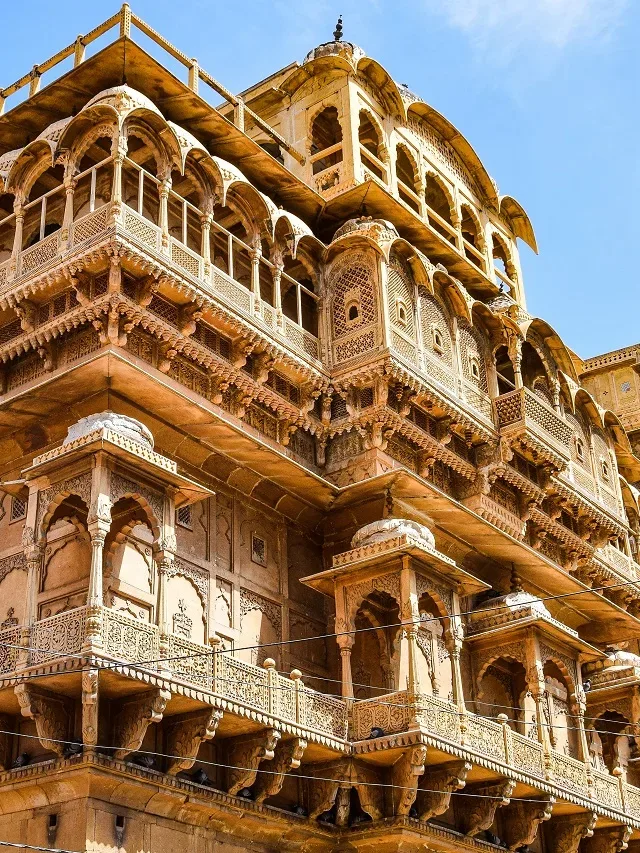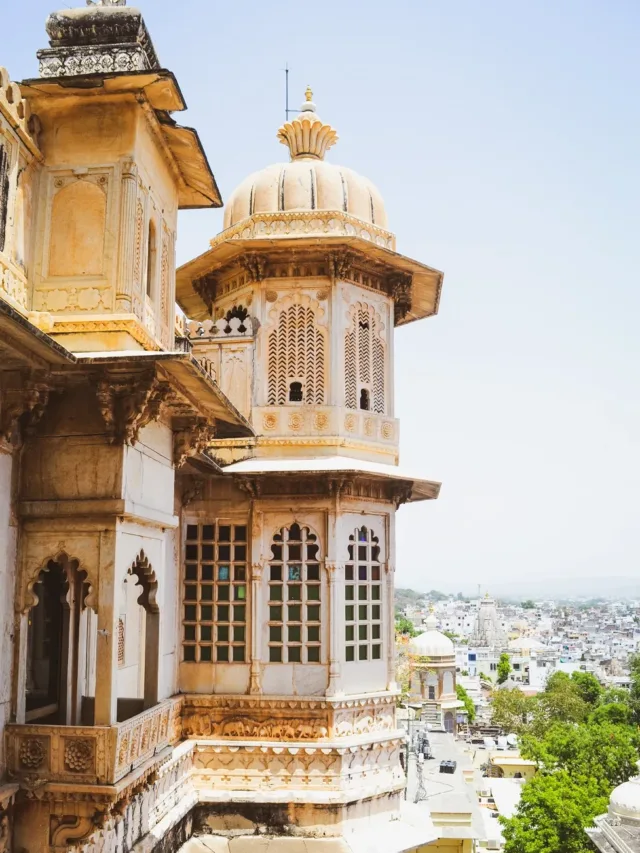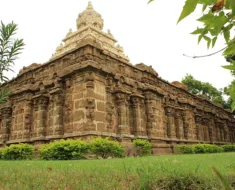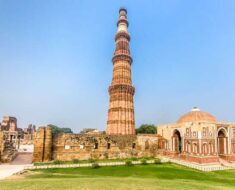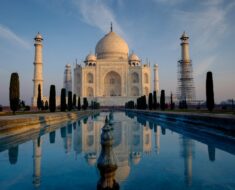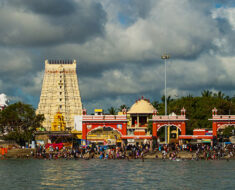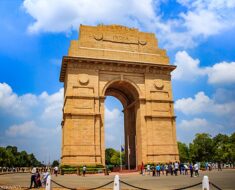India is a country boasting thousands of years of rich history and culture and has seen the rise and fall of some of the greatest empires in the world.
It’s often said that there is something magical about old Forts and Palaces for they hold within them annals of a piece of history and classic heritage that can be felt and experienced even today.
Rajasthan the ‘Land of Maharajas’ boasts of rich history and heritage and is home to the series of Hill Forts of Rajasthan a designated UNESCO World Heritage Site.
The magnificent forts were built between the 8th and 18th centuries by several Rajput rulers. Located in the Aravallis this group of Hill forts of Rajasthan were designated UNESCO World Heritage Site in 2010.
Here is a List of the Six Hill Forts of Rajasthan
- Chittorgarh Fort – Chittorgarh
- Kumbhalgarh Fort – Rajsamand
- Ranthambore Fort – Sawai Madhopur
- Gagron Fort – Jhalawar
- Amer Fort – Jaipur
- Jaisalmer Fort – Jaisalmer
Chittorgarh Fort

Chittorgarh Fort is a UNESCO World Heritage Site and one of the hill forts of Rajasthan. The fort holds significant historical, and cultural importance and is a testament to the valour and resilience of the Rajput warriors.
The fort is believed to be built in the 7th century AD by the Mauryans and is one of India’s largest forts spread over an area of 691.9 acres. The fort gets its name from the Mauryan ruler, Chitrangda Mori.
The fort is surrounded by massive walls and is famous for its seven gates namely Padan Gate, Ganesh Gate, Hanuman Gate, Bhairon Gate, Jodla Gate, Lakshman Gate and the main gate named after Lord Ram. The massive fort complex is roughly shaped like a fish when viewed from a bird’s eye view.
The Chittorgarh Fort houses many palaces, like the Rana Kumbha Palace, the Fateh Prakash Palace, the Vijay Stambh, Kirti Stambh, Rani Padmini’s Palace and many historic temples like Kalika Mata Temple, Meerabai Temple, Sammidheshwara Temple, Neelkanth Mahadev Temple and Kumbha Shyam Temple within the fort.
- Best time to Visit: November to February
- Timings: 9.30 am to 5.30 pm
- Entry Fee: ₹ 20 (adults); ₹ 15(children below 15 years)
Read More: 15 Famous Historical Places in Rajasthan
Kumbhalgarh Fort
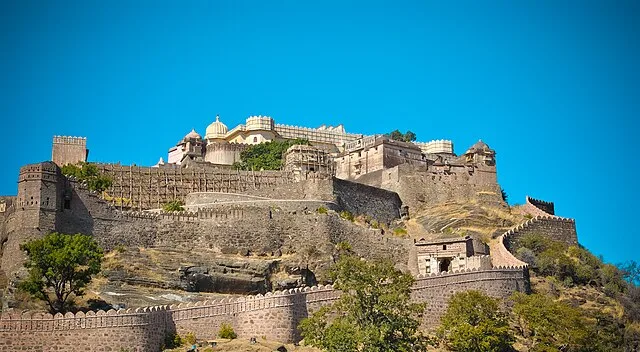
Kumbhalgarh Fort is located in the foothills of the Aravalli Mountain Range and is known for its 38-kilometre wall, the second longest in the world after the Great Wall of China.
The fort is situated about 48 km from Rajsamand city and was built by Mewar King Rana Kumbha in the 15th century. Also known as the Mewar Fortress is the birthplace of Maharana Pratap, a great Rajput king.
The front walls of the fort are 4.5 m, and it has seven fortified gateways. There are over 360 Hindu and Jain temples within the fort, indicating the religious tolerance of the rulers and how they patronized the Jains, encouraging their culture in the kingdom.
- Best time to Visit: November to February
- Timings: 9.00 am to 5.00 pm
- Entry Fee: ₹ 10
Ranthambore Fort

Ranthambore Fort is located within the Ranthambore National Park in Sawai Madhopur and is one of the major historical places in Rajasthan. The national park around the fort used to be the hunting grounds of the Maharajahs of Jaipur until the Independence of India.
The Fort provides a panoramic view of the surrounding Ranthambore National Park and is a UNESCO World Heritage Site under the group Hill Forts of Rajasthan. The fort was built in 944 AD by the Chauhan rulers and has witnessed many sieges and battles.
The most famous war was between Rao Hamir and the Muslim invader Alauddin Khilji in 1301. During this war, the Royal women performed “Jauhar“.
The fort is protected by a large wall with seven gates for entry and exit. There are many structures like Toran Dwar, Mahadeo Chhatri and Sametonki Haveli and also temples dedicated to Ganesha, Shiva and Ramlalaji constructed in the 12th and 13th centuries within its premises.
- Best time to Visit: November to May
- Timings: 6.00 am to 6.00 pm
- Entry Fee: ₹ 15
Read More: Top 10 Places to Visit in Jodhpur
Gagron Fort

Gagron Fort is a masterpiece of Rajput architecture. The fort is surrounded by the Kali Sindh and Ahu rivers on all three sides and a moat on the fourth side. Situated in Jhalawar the fort was built by Rajput King Bijaldev Singh Dod in the 12th century and is a stunning example of a hill and water fort.
It is the only fort in North India surrounded by water and has been named the Jaladurga (Water Fort) of India. The fort also boasts three ramparts as compared to the traditional forts having only two ramparts. It has two colossal main gates and some other important gates inside the fort are Bhairavi Pol, Ganesh Pol, Kishan Pol, Nakkarkhana and Selekhana.
The Grand Fort complex has many important structures and temples like the Janaana Mahal, Rang Mahal, Diwan-i-Aam, Diwan-e-Khas, and Madhusudan Mandir inside it.
There is a mausoleum of Sufi Saint Mitthe Shah outside the fort and a fair is held every year during the month of Muharram to mark the respect for the Sufi Saint. There is also a monastery of Saint Pipaji across the confluence
The historical fort has withstood 14 battles and 2 jauhars of queens. The fort was also conquered by Sher Shah and Akbar. Akbar made the fort a headquarters and later gave it to Prathviraj of Bikaner.
- Best time to Visit: October to March
- Timings: 9.00 am to 4.30 pm
- Entry Fee: Free
Read More: 15 Must-Visit Historical Places in India
Amer Fort

The magnificent Amber Fort also known as Amer Fort is one of the top tourist attractions of Jaipur. It is an extensive palace complex that has been built with pale yellow and pink sandstone, and with white marble.
The Fort was constructed by Raja Man Singh in 1592 AD and later expanded and renovated by Raja Jai Singh I. The Fort is a great example of Rajput architecture and some of its structures and works have Mughal architecture influence.
The fort is laid out on four levels, each having a courtyard. The palace complex has many structures like the Diwan-e-Aam, the Diwan-e-Khas, the Palace of Man Singh I, the Sila Devi temple, the Sheesh Mahal, the Sukh Mahal, the Tripolia Gate, and the Lion Gate.
- Best time to Visit: November to February
- Timings: 9.30 am to 5.30 pm
- Light and Sound Show: 7.30 pm (English); 8.00 pm (Hindi)
- Entry Fee: ₹ 20 (adults); ₹ 10(students)
Jaisalmer Fort

Jaisalmer Fort perched atop Trikuta Hill offers stunning views of Jaisalmer city and is one of the famous hill forts in Rajasthan.
The fort is a 250-foot-tall structure and is also known as the Golden Fort or Sonar Qila. It was built by the Rajput ruler Rawal Jaisal in 1156 AD and was reinforced by subsequent rulers of Jaisalmer.
The fort is made of yellow sandstone, which gives it a golden hue and is considered one of the oldest continuously inhabited forts in the world. It’s also one of the few “living forts” in the world, with about a quarter of the old city’s population still living within its walls.
The fort is a complex that includes temples, shops, and houses. Its walls are about 30 meters high and are fortified with bastions. The fort has four fortified entrances, one of which was previously guarded by a cannon.
- Best time to Visit: October To March
- Timings: 9.00 am to 5.00 pm
- Entry Fee: ₹ 50


